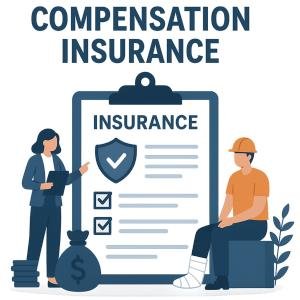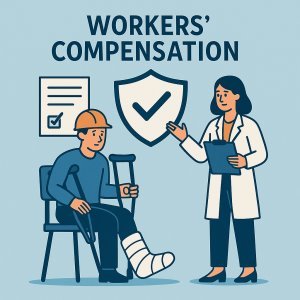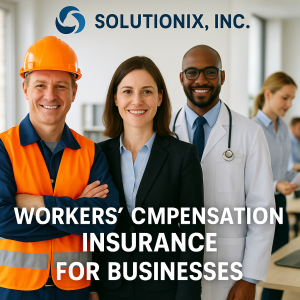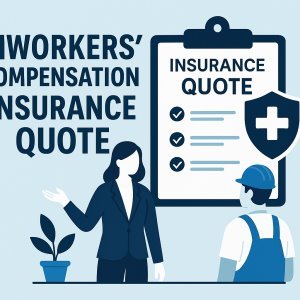
Georgia Workers’ Comp Requirements for Temp Staffing
July 23, 2025
Georgia Staffing Firm Workers’ Comp Insurance Guide
July 23, 2025
An illustration depicting workers’ compensation insurance with a worker and a clipboard.
Navigating the maze of workers’ compensation can feel like walking a tightrope-balancing cost, coverage, and compliance without losing your footing. For businesses seeking affordable solutions, employee leasing firms frequently enough emerge as a practical option, promising streamlined processes and budget-kind plans. But how do you separate the genuinely cost-effective from the seemingly cheap? This guide dives into the world of employee leasing companies, unraveling how they manage workers’ comp insurance, what to watch out for, and how to make smart choices that protect both your bottom line and your workforce. whether you’re a small business owner or HR professional,understanding this landscape can turn the complex challenge of workers’ comp into a manageable asset.
Table of Contents
- understanding Workers’ Compensation Costs in Employee Leasing
- evaluating the Benefits and Risks of Affordable Workers’ Comp Plans
- Key Factors to Consider When Choosing a Workers’ Compensation Provider
- Strategies for Managing Claims and Reducing Expenses Effectively
- Q&A
- Closing Remarks
Understanding Workers’ Compensation Costs in Employee Leasing

When diving into the financials of workers’ compensation in an employee leasing scenario, it’s essential to recognize that these costs are a blend of multiple factors, not just a flat rate. Leasing firms negotiate rates based on the industry risks, employee roles, and past claims history of the client company. This means a business with more hazardous job functions may face higher premiums, as the risk of injury spikes. On the flip side,companies with extensive safety programs and minimal past claims can negotiate more competitive pricing. The key to managing these costs is openness and proactive dialog between the leasing firm and the client, ensuring that risk evaluations are up-to-date and that claims data is thoroughly reviewed.
Beyond the obvious variables, workers’ comp costs in leasing also hinge on how the firm bundles services. Below is a breakdown showing common factors that influence pricing in this space:
| Factor | Impact on Cost | Why It Matters |
|---|---|---|
| employee Classification | High | Different jobs carry different injury risks |
| Claims History | Moderate to High | Past injuries indicate future risk level |
| Safety Programs | Moderate | Strong initiatives can reduce claims |
| Payroll Size | Proportional | Higher payroll means higher premium base |
| State Regulations | Variable | Comp laws vary by jurisdiction |
- Injury risk assessments determine the starting point of cost calculations.
- Experience mod factors adjust rates based on your company’s claims record.
- Administrative fees may be added on top of insurance premiums by the leasing firm.
Evaluating the Benefits and Risks of Affordable Workers’ Comp Plans
- Claim processing efficiency and support quality
- Policy inclusions and exclusions
- Long-term financial implications beyond premiums
- Reputation and financial stability of the insurer
| Benefit | Risk |
|---|---|
| Lower upfront premiums | Potential coverage gaps |
| ease of access to basic support | Delayed claim settlements |
| Cost control in the short term | Higher out-of-pocket expenses later |
Key Factors to Consider When Choosing a Workers’ Compensation Provider
When selecting a workers’ compensation provider, it’s crucial to look beyond just cost and focus on the quality of coverage and service. Consider providers that offer comprehensive claim management systems to support both employers and employees efficiently. This ensures speedy turnaround times and reduces the administrative burden on your business. Access to a wide network of healthcare professionals and clear communication channels are also essential for seamless claim processing.
Another vital aspect is the provider’s financial stability and reputation. Partnering with a well-established firm minimizes risks related to claim payments or legal complications down the line. here’s a quick checklist to help you weigh your options:
- Coverage options tailored to your specific industry
- Clear and competitive premium structures
- Proven record of reducing workplace injuries through safety programs
- Customer support availability and responsiveness
- Compliance with state regulations and annual reporting
Strategies for Managing Claims and Reducing Expenses Effectively
Controlling workers’ compensation costs isn’t just about cutting rates-it’s about smart management and proactive prevention. Start by thorough documentation and clear communication with your team members.This practice not only accelerates claim processing but also helps identify patterns that could signify systemic risks. Partnering with medical providers who specialize in occupational health can expedite treatment and recovery, minimizing downtime and medical expenses. Encourage a workplace culture that prioritizes safety by implementing regular training sessions and incentivizing compliance.
Effective claim handling thrives on these key tactics:
- Early reporting and swift inquiry of incidents
- Collaborative return-to-work programs tailored to individual recoveries
- Use of data analytics to track claim frequency and costs
- Regular audits to detect potential fraud and reduce unnecessary claims
| Strategy | Impact | Example |
|---|---|---|
| Early Incident Reporting | Reduces investigation time | Employee notifies supervisor within 1 hour |
| return-to-work Program | Decreases lost workdays | Modified duties starting day 3 post-injury |
| Data Analytics | Identifies high-risk activities | Monthly claim trend reports |
| Fraud Audits | Limits false claims | Quarterly autonomous review |
Q&A
Q&A: cheap Workers’ Comp? Employee Leasing Firm Guide
Q1: What is workers’ comp and why is it critically important for businesses?
A1: Workers’ compensation, commonly known as workers’ comp, is an insurance program that provides benefits to employees who suffer job-related injuries or illnesses. It’s crucial as it protects both employees by covering medical expenses and lost wages, and employers by limiting liability and legal exposure.
Q2: How can an employee leasing firm help businesses manage workers’ comp costs?
A2: Employee leasing firms, also known as Professional Employer Organizations (PEOs), streamline workers’ comp management by pooling multiple clients under a single insurance policy. This collective power often results in lower premiums, improved claims handling, and reduced administrative burden for businesses.
Q3: Are workers’ comp rates always cheaper through employee leasing firms?
A3: Not necessarily. While employee leasing firms can offer competitive rates thanks to their volume and expertise, prices vary based on industry risk, claim history, and state regulations. It’s important for businesses to compare firms carefully rather than assuming cheaper means better.
Q4: What should businesses look for when choosing an employee leasing firm to save on workers’ comp?
A4: Look for a firm with a solid reputation, transparent pricing, strong safety programs, and excellent claims management. Also, verify that they hold proper licenses and operate in your state. Their ability to tailor solutions to your industry’s risk profile is a major advantage.
Q5: Can small businesses benefit from employee leasing firms for workers’ comp?
A5: Absolutely. Small businesses often find it challenging to obtain affordable workers’ comp due to limited bargaining power. Employee leasing firms aggregate small clients, providing access to group-rated policies that might otherwise be inaccessible or costly.
Q6: What are potential downsides to using an employee leasing firm for workers’ comp?
A6: Potential downsides include less direct control over claims processing, possible fees or contract lock-ins, and the need to thoroughly vet the firm’s service quality. Businesses must weigh cost savings against these factors to decide if leasing meets their needs.
Q7: How does an employee leasing firm handle claims differently than a conventional insurer?
A7: Leasing firms often have dedicated risk management teams that proactively work to prevent claims and manage them efficiently if they occur. This hands-on approach can speed up claim resolution and promote workplace safety, sometimes improving overall costs.Q8: Is the employee leasing firm responsible for paying workers’ comp claims?
A8: Typically, yes.The leasing firm acts as the employer of record and holds the workers’ comp policy, thus they handle claim payments and administration. This arrangement relieves the client business from direct responsibilities associated with claims.
Q9: How should businesses assess the true cost of workers’ comp through a leasing firm?
A9: Beyond premium rates, consider fees, service charges, and potential savings from safety programs or injury prevention resources offered by the leasing firm. A comprehensive cost-benefit analysis will reveal the actual financial impact.
Q10: What’s the key takeaway for businesses considering cheap workers’ comp via employee leasing?
A10: Affordable workers’ comp through employee leasing is absolutely possible but requires due diligence. Prioritize quality service, proven safety support, and transparent pricing over just the lowest quote. When chosen wisely, leasing firms can be a powerful ally in managing workers’ comp effectively and economically.
Closing Remarks
In the ever-evolving landscape of employee leasing and workers’ compensation, finding affordable coverage without sacrificing peace of mind is both an art and a science. By understanding the ins and outs of workers’ comp through an employee leasing firm, businesses can unlock opportunities to safeguard their workforce while optimizing expenses. As with any crucial decision, a well-informed approach backed by thorough research and trusted partners will always pay dividends in the long run. Whether you’re a small startup or a growing enterprise, navigating the maze of cheap workers’ comp options is no longer an intimidating task but a strategic step toward smarter, safer business operations.
“This content was generated with the assistance of artificial intelligence. While we strive for accuracy, AI-generated content may not always reflect the most current information or professional advice. Users are encouraged to independently verify critical information and, where appropriate, consult with qualified professionals, lawyers, state statutes and regulations & NCCI rules & manuals before making decisions based on this content.”








